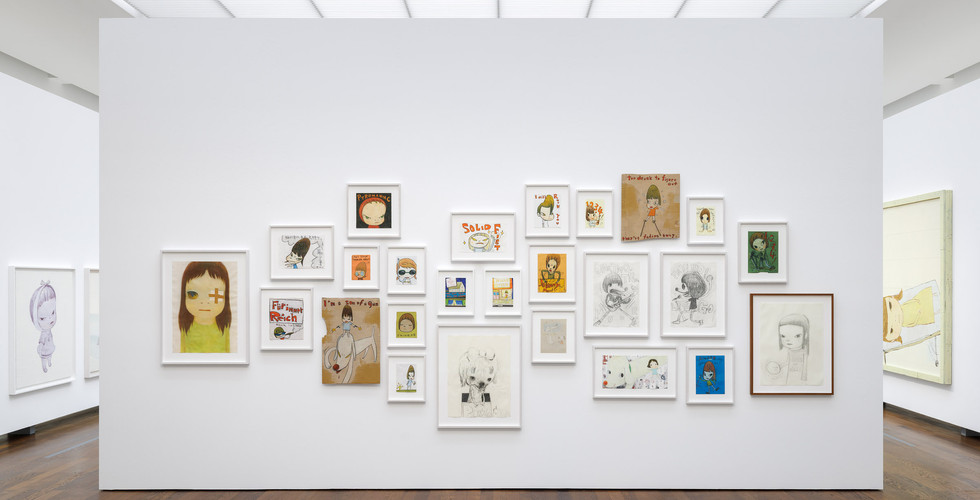In a significant cultural moment for Germany's art scene, the Museum Frieder Burda in Baden-Baden is hosting the first major German retrospective of internationally acclaimed Japanese artist Yoshitomo Nara. Running from November 23, 2024, to April 27, 2025, this comprehensive exhibition showcases four decades of Nara's artistic journey through paintings, drawings, sculptures, and installations.

Yoshitomo Nara in front of Harmless Kitty (Detail), 1994 in the Museum Frieder Burda. The National Museum of Modern Art, Tokio © Yoshitomo Nara, courtesy Yoshitomo Nara Foundation; photo: Nikolay Kazakov
Nara, born in 1959, has established himself as one of the most celebrated artists of his generation, particularly known for his iconic "Angry Girls" series - large-format portraits featuring subjects with mesmerizing, confrontational gazes. These works, which have become synonymous with contemporary painting, represent just one facet of Nara's multifaceted artistic expression.
The exhibition offers a deeply personal glimpse into Nara's world, reflecting various chapters of his life journey. His artwork serves as a visual diary, chronicling experiences ranging from his solitary childhood in Japan to his period of isolation as an art student in Germany. The influence of underground rock, folk, and punk music, combined with his passion for literature, cinema, and nature, weaves through his body of work, creating a unique artistic vocabulary that bridges Japanese and European artistic traditions.
Nara's artistic development has been particularly shaped by his early years. Growing up with working parents and much older siblings, he spent considerable time alone, finding solace in drawing and music. The Far East Network (FEN), broadcasting American troops' radio programs during the Vietnam War, became his window to the world, introducing him to influential artists like Bob Dylan and exposing him to antiwar messages through folk music. Despite the language barrier, Nara absorbed these musical influences on a sensory level, translating them into his distinctive visual language.

Yoshitomo Nara, Sleepless Night (Sitting), 1997. Courtesy of Rubell Museum, Miami & Washington, D.C. © Yoshitomo Nara, courtesy Yoshitomo Nara Foundation

Yoshitomo Nara, Missing in Action, 1999. Courtesy of Sally and Ralph Tawil © Yoshitomo Nara, courtesy Yoshitomo Nara Foundation
In contrast to Japan's prevalent kawaii (cute) aesthetic, Nara's work presents a more complex emotional landscape. His famous Angry Girls series challenges the notion of sweetness and innocence, instead portraying figures that embody rebellion and defiance. These characters reflect Nara's pacifist stance and social criticism, particularly influenced by his examination of Japan's role in World War II.
The artist's political consciousness extends beyond historical reflection. Following his 2002 journey to Afghanistan to document the war through drawings and photographs, Nara's work has increasingly engaged with contemporary political issues. The 2011 Fukushima nuclear disaster particularly influenced his artistic direction, leading him to support antinuclear movements and environmental causes. His powerful imagery has become a familiar sight at political demonstrations, where his unambiguous messages resonate with activists worldwide.
Nara's artistic evolution is deeply connected to his educational journey. After studying painting in Aichi, his 1980 journey to Europe exposed him to European modernism and Renaissance art, influences visible in his work's composition and technique. His time at Düsseldorf's Kunstakademie under A. R. Penck proved transformative, leading to the development of his characteristic style - particularly his distinctive child figures with large heads and widely-spaced eyes that create an immediate emotional connection with viewers.
Yoshitomo Nara, My Drawing Room 2008, Bedroom Included, 2008. Collection of the Artist, Ausstellung Museum Frieder Burda, Baden-Baden 2024 © Yoshitomo Nara, courtesy Yoshitomo Nara Foundation; photo: Nikolay Kazakov
Yoshitomo Nara, Midnight Tears, 2023. Collection of the Artist, Ausstellung Museum Frieder Burda, Baden-Baden 2024 © Yoshitomo Nara, courtesy Yoshitomo Nara Foundation; photo: Nikolay Kazakov
Yoshitomo Nara, exhibition at Museum Frieder Burda, Baden-Baden 2024 © Yoshitomo Nara, courtesy Yoshitomo Nara Foundation; photo: Nikolay Kazakov
The current exhibition, organized in collaboration with the Guggenheim Museum Bilbao, Museum Frieder Burda and London's Hayward Gallery, features masterpieces from prestigious institutions including the Jumex Collection and the Leeum Museum of Art, alongside rarely-seen works from private collections. This comprehensive retrospective not only celebrates Nara's artistic achievement but also marks a poignant return to Germany, a country that played a crucial role in shaping his artistic vision.
YOSHITOMO NARA
Dates: November 23, 2024–April 27, 2025
Venue: Museum Frieder Burda, Baden-Baden, Germany
(Lichtentaler Allee 8b, 76530 Baden-Baden)
Opening hours: Tuesday to Sunday, 10 a.m. to 6 p.m.
Open on all holidays, except December 24 and 31








